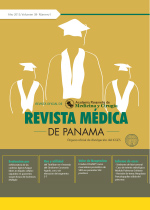Infección por COVID-19 en pacientes en Hemodiálisis en Panamá 2020
Autores/as
DOI:
https://doi.org/10.37980/im.journal.rmdp.20211787Palabras clave:
Hemodiálisis, COVID-19, mortalidad, Panamá, enfermedad renal crónicaResumen
Antecedentes y objetivo: Los pacientes con Enfermedad Renal Crónica (ERC) en Hemodiálisis son pacientes que tienen condiciones que los hacen pacientes de riesgo para la infección por COVID-19. Los pacientes en hemodiálisis han sido un grupo muy afectado, debido a que no pueden suspender sus tratamientos para mantener el aislamiento domiciliario, lo que aumenta su exposición y riesgo a infección por COVID-19. Para evaluar el comportamiento de la infección por SARS-CoV-2 en los pacientes en hemodiálisis crónica en Panamá, realizamos un estudio prospectivo de los pacientes infectados por COVID-19 en las Unidades de Hemodiálisis de la CSS de todo el país, para determinar las características de los pacientes afectados, los síntomas que presentaron, su evolución clínica y el desenlace de los pacientes infectados.
Materiales y Médodos: Realizamos un estudio longitudinal descriptivo prospectivo multicéntrico de los casos positivos que se diagnosticaron desde el 15 de julio hasta el 31 de diciembre de 2020 en las 14 Unidades de Hemodiálisis de la CSS del país.
Resultados y conclusiones: Fueron incluidos un total de 333 pacientes en hemodiálisis con diagnóstico positivo para infección por SARS-CoV-2, de un total de 2194 pacientes que realizan hemodiálisis en las Unidades de la Caja de Seguro Social. El 59.5% de los afectados fueron de sexo masculino. La edad promedio fue de 56.75 años (DS 15.1 años). La Tasa de Mortalidad encontrada en nuestro estudio fue de 26%. La incidencia acumulada de COVID-19 en pacientes en Hemodiálisis fue de 16% para el período de estudio del 2020.
Publicado
Número
Sección
Licencia
Derechos de autor 2021 Infomedic Intl.Derechos autoriales y de reproducibilidad. La Revista Médica de Panama es un ente académico, sin fines de lucro, que forma parte de la Academia Panameña de Medicina y Cirugía. Sus publicaciones son de tipo acceso gratuito de su contenido para uso individual y académico, sin restricción. Los derechos autoriales de cada artículo son retenidos por sus autores. Al Publicar en la Revista, el autor otorga Licencia permanente, exclusiva, e irrevocable a la Sociedad para la edición del manuscrito, y otorga a la empresa editorial, Infomedic International Licencia de uso de distribución, indexación y comercial exclusiva, permanente e irrevocable de su contenido y para la generación de productos y servicios derivados del mismo. En caso que el autor obtenga la licencia CC BY, el artículo y sus derivados son de libre acceso y distribución.






